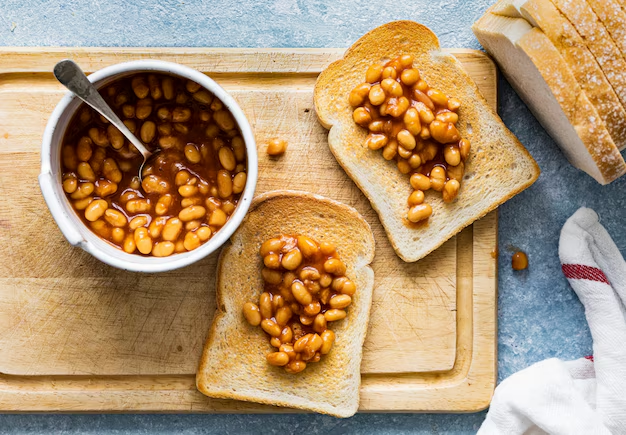Baked beans are a staple in many households around the world. They are a versatile dish, enjoyed as a side at barbecues, a main course for breakfast, or even a hearty snack. But one question that often comes up is: What kind of beans are used in baked beans? This article will explore the different types of beans commonly used in baked beans recipes, from the classic navy beans to more unique options like black and kidney beans. We will delve into the characteristics of each type, their suitability for baked beans, and how to choose the best beans for your recipe.
For a deeper understanding of flavor combinations and complementary dishes, you might find our articles on Honey Pepper Chicken with Creamy Macaroni & Cheese and Mississippi Mud Potatoes particularly useful.
Types of Beans Commonly Used in Baked Beans
Navy Beans: The Classic Choice
Navy beans are the most traditional choice for baked beans. They are small, white beans that cook up soft and tender, absorbing the flavors of the sauce beautifully. Navy beans are known for their mild flavor and ability to blend seamlessly with other ingredients.
Why Navy Beans?
- Texture: Navy beans become soft and creamy when cooked, making them ideal for a dish like baked beans where you want the beans to meld with the sauce.
- Flavor: Their mild flavor allows the other ingredients in the dish to shine, particularly the molasses, brown sugar often used in recipes.
- Cooking Time: Navy beans cook relatively quickly compared to other beans, which is another reason they are preferred in the dish recipes.
For a recipe that highlights the classic use of navy beans, check out our Baked Beans Recipe, which offers a detailed guide to making this beloved dish.
Great Northern Beans: A Versatile Alternative
Great northern beans are another popular option for the dish. They are slightly larger than navy beans and have a delicate, nutty flavor. These beans hold their shape well during cooking, making them a good choice for baked beans that are a bit more structured.
Why Great Northern Beans?
- Flavor: The mild, nutty flavor of great northern beans complements the sweetness of the dish sauce, while also adding a subtle depth.
- Texture: Great northern beans are slightly firmer than navy beans, which can add a pleasing texture contrast in the dish.
- Versatility: These beans can be used in a variety of dishes, not just baked beans, making them a versatile pantry staple.
Explore our French Onion Rice for another dish that benefits from the nutty flavor of great northern beans.
Pinto Beans: Adding a Southwestern Twist
Pinto beans are commonly used in Southwestern cuisine, but they also make a flavorful addition to baked beans. They are medium-sized beans with a creamy texture and a slightly earthy, rich flavor.
Why Pinto Beans?
- Flavor: Pinto beans bring a rich, earthy flavor to the dish, adding a new dimension to the dish.
- Texture: These beans are creamy when cooked, which makes them blend well with the sauce.
- Cultural Variation: Pinto beans are often used in Mexican and Southwestern dishes, so they can give your the dish a unique twist if you’re looking to experiment with flavors.
For more creative ways to use pinto beans, our Cajun Chicken Sloppy Joes offers a delicious fusion of flavors that pairs well with the beans’ earthiness.
Cannellini Beans: The Italian Influence
Cannellini beans are large white beans that are often used in Italian cooking. They have a slightly nutty, mild flavor and a creamy texture, making them an excellent choice for a more refined dish.
Why Cannellini Beans?
- Flavor: Cannellini beans have a subtle flavor that doesn’t overpower the dish, making them a good base for more complex recipes.
- Texture: These beans are soft and creamy, which allows them to blend well into the sauce while still holding their shape.
- Culinary Inspiration: For an Italian twist on the dish, cannellini beans are the go-to choice.
If you enjoy experimenting with different cuisines, our Chicken Tortelloni Alfredo recipe provides a great example of how cannellini beans can be incorporated into a rich and creamy dish.
Specialty Beans and Their Uses in Baked Beans
Black Beans: A Hearty and Rich Option
Black beans are a less common but delicious choice for baked beans. They have a robust, slightly sweet flavor and a firm texture that stands up well in baked beans.
Why Black Beans?
- Flavor: Black beans add a rich, hearty flavor that pairs well with smoky or spicy elements in baked beans.
- Texture: Their firm texture ensures that the beans don’t become too mushy, even after long cooking times.
- Visual Appeal: The dark color of black beans adds a striking contrast to the typically lighter sauce of baked beans, making the dish visually appealing.
Consider pairing black beans with our Blackberry Cheesecake for a dessert that complements the richness of the beans.
Kidney Beans: Bold Flavor and Color
Kidney beans are another excellent option for baked beans. They are large, kidney-shaped beans with a deep red color and a slightly sweet, robust flavor.
Why Kidney Beans?
- Flavor: The bold flavor of kidney beans makes them stand out in baked beans, adding depth and complexity to the dish.
- Texture: Kidney beans hold their shape well, providing a nice contrast in texture to softer beans like navy or pinto beans.
- Color: The deep red color of kidney beans can make your baked beans more visually appealing, especially when combined with other bean types.
For a dish that complements the bold flavor of kidney beans, try our Steak and Pasta Dishes, which pairs well with the heartiness of the beans.
Cooking Techniques for Different Types of Beans
Preparing Dried Beans for Baked Beans
Using dried beans can elevate the flavor and texture of your baked beans, but it requires a bit more preparation. Here’s how to do it:
Steps:
- Soaking: Place the dried beans in a large bowl and cover with water. Let them soak overnight to reduce cooking time and improve texture.
- Rinsing: After soaking, drain and rinse the beans to remove any residual starch or impurities.
- Cooking: Cook the beans in a pot of fresh water until they are tender but not mushy. This will ensure they hold up well during the baking process.
For those who prefer to avoid the soaking process, our Rice Pudding Recipe offers a quicker alternative to using dried beans in a different comfort food setting.
Canned Beans: A Convenient Alternative
Canned beans are a convenient option for making baked beans, especially when you’re short on time. However, there are a few tips to ensure they deliver the best possible flavor.
Tips for Using Canned Beans:
- Rinsing: Always rinse canned beans under cold water to remove excess salt and improve the texture.
- Simmering: Simmer the canned beans in water or broth for a few minutes before adding them to your recipe. This helps them absorb more flavor and reduces the metallic taste that canned beans can sometimes have.
- Seasoning: Adjust the seasoning to taste, as canned beans are often already salted.
Canned beans work well in a variety of dishes, such as our Spinach Chicken Mushroom Lasagna, where convenience meets flavor.
Recipes and Variations
Classic Baked Beans Recipe Using Navy Beans
Here’s a traditional recipe using navy beans, which will give you that classic, comforting flavor.
Ingredients:
- 2 cups navy beans (soaked overnight)
- 1 onion, diced
- 3 cloves garlic, minced
- 1/2 cup molasses
- 1/4 cup brown sugar
- 2 tbsp mustard
- 2 tbsp ketchup
- Salt and pepper to taste
Steps:
- Sauté the Onion and Garlic: Add the onion and garlic to the sauté until softened.
- Combine Ingredients: Add the soaked navy beans, molasses, brown sugar, mustard, ketchup, salt, and pepper to the pot. Stir to combine.
- Bake: Cover the pot and bake in a preheated oven at 250°F (120°C) for 3-4 hours, or until the beans are tender and the sauce has thickened.
- Serve:
This classic recipe is a great starting point, but feel free to experiment with different beans and seasonings to make it your own.
Baked Beans with a Twist: Using Specialty Beans
For a unique variation, try incorporating black beans or kidney beans into your dish recipe. Here’s how you can do it:
Ingredients:
- 1 cup navy beans (soaked overnight)
- 1 cup black beans (soaked overnight)
- 1 cup kidney beans (soaked overnight)
- 1 onion, diced
- 3 cloves garlic, minced
- 1/2 cup molasses
- 1/4 cup brown sugar
- 2 tbsp mustard
- 2 tbsp ketchup
- 1 tsp chili powder
- Salt and pepper to taste
Steps:
- Sauté the Onion and Garlic: Add the onion and garlic to the sauté until softened.
- Combine Ingredients: Add the soaked beans, molasses, brown sugar, mustard, ketchup, chili powder, salt, and pepper to the pot. Stir to combine.
- Bake: Cover the pot and bake in a preheated oven at 250°F (120°C) for 3-4 hours, or until the beans are tender and the sauce has thickened.
- Serve:
This variation provides a more complex flavor profile and a vibrant appearance, perfect for impressing guests.
FAQs
What are the best beans for baked beans?
- Navy beans are the most traditional, but great northern, pinto, cannellini, black, and kidney beans all work well depending on the flavor and texture you desire.
Can you mix different types of beans in baked beans?
- Absolutely! Mixing beans can add complexity to the dish. Just be sure to adjust cooking times accordingly, as different beans may cook at different rates.
Are canned beans as good as dried beans for baked beans?
- Both have their advantages. Canned beans are convenient and quick, while dried beans offer more control over texture and flavor. For the best results, try using a combination of both.
Conclusion
Choosing the right beans for your the dish recipe can significantly impact the final dish. Whether you opt for the classic navy beans, experiment with great northern or pinto beans, or add a twist with black or kidney beans, each type offers its own unique qualities that can elevate your baked beans.
For more inspiration on complementary dishes, explore our Honey Butter Skillet Corn and Pioneer Woman Cheeseburger Pie, both of which pair beautifully with a hearty serving of baked beans.

